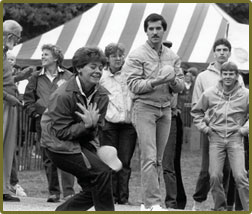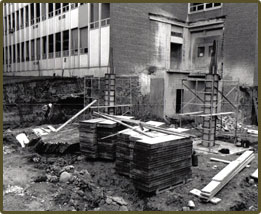Heritage & Traditions at Aquinas College
1980 to 1989
1980
Harbor Springs II, an all-College retreat featuring faculty, administrators, staff and members of the Board of Trustees. A continuation of the College's revisioning process.


1982
Aquinas athletes enjoy continuing success. Fabian Knizacky set records in racewalking
and competed on the national scene in that event. Pitchers Dave Gumpert and Paul Assenmacher
lead the Saints to victory and later go on toe major league careers. Dave Gumpert,
pitching for the Kansas Royals, is elected to the National Association of Intercollegiate
Athletics Baseball Hall of Fame in 1988. In 1995 and 1997, Assenmacher pitched relief
in the World Series for the Cleveland Indians. In the mid-1980's, volleyball coach
Sharon Schatz takes teams to numerous conference championships and international competition
in the summer months.
Reception for the Holmdene renovation in 1982. The original building, erected in 1908 as part of the Lowe family estate, had been used since 1955 as a residence for Dominican sisters who taught and worked at the college. In the early 1980's, the building was transformed from a residence to an office space for administrators, including the president, and faculty from several academic departments. In 1982, the building received historical landmark status from the Grand Rapids Historic Preservation Committee. Even though the building had to be brought up to modern fire code with enclosed staircases, the historic feel of the interior rooms was preserved.
1984




1985
The Insignis Program for Honors Students is founded by Gary Eberle to be an educational enhancement program serving the needs of high achieving students. Offering special seminars and senior projects which encourage students to go into greater depth in their majors, the program will eventually grow from the initial twelve students to over one hundred.

Mid-1980s Quiz Bowls find out who has the most trivial mind on campus.

Returning alumni challenge the current AQ basketball team at 1985 homecoming.


1986
As one of his final initiatives while in office, President Hruby initiates "age integration,"
erasing the line between traditional age and continuing education students, thus streamlining
the administration and encouraging greater age diversity in the classroom.
Women's soccer is added as a new sport in the mid-1980's and soon becomes a power in the WHAC.
The Women's Center opens on campus to focus on the needs of women. Eventually, the Women's Studies Minor
is added to the curriculum.

Aquinas sports legend Laray Hardy on his way to the record books in 1986. Hardy scored 2,643 points in his career at Aquinas, setting a still-standing college record and making him one of the highest scoring collegiate players nationally.

After a long Michigan winter, Aquinas students celebrate with "Thank God It's Spring," 1986. This annual day of fun and frivolity becomes a fixture of campus life for several years balancing fall's Gala Weekend.

Norbert Hruby retires from the presidency in 1986 after 16 years of innovation and advancement. The legacy of his presidency is a number of new programs serving previously underserved populations. His replacement is Dr. Peter D. O'Connor who is chosen to be the third president of Aquinas College lead it into the 1990's.

1987
Dr. Peter J. O'Connor is selected as the third president of Aquinas College. Almost
immediately, O'Connor puts into place an ambitious campus plan, taking on deferred
maintenance projects and planning for campus expansion. Changes in technology include
the laying of fiber optic cable in anticipation of campus computerization, and a renovation
of Albertus Magnus Hall of Science.
The College purchases Christopher House and 10.5 acres of grounds on Woodward Lane and Robinson Road from the Catholic diocese
to meet the needs of an expanding Emeritus College and to provide space for further growth.




1988
The Spectrum Scholarship Competition is begun to attract high-achieving students to Aquinas. Aimed at drawing academic
and campus leaders, it offers five full scholarships to students who compete in this
annual Saturday invitation-only competition. Eventually, several hundred students
compete annually for the scholarships. The winners of the competition automatically
become members of the Insignis Program for Honors students. To hear an automated message from "Silicon Sal," the official voice of Aquinas' phone-mail,
click here. You will be linked to an audio clip from "Historically Speaking: an oral history
of Aquinas College."
To hear an automated message from "Silicon Sal," the official voice of Aquinas' phone-mail,
click here. You will be linked to an audio clip from "Historically Speaking: an oral history
of Aquinas College."
In July 1988, officials of Reformed Bible College and Aquinas College agree to the terms of a contract for the sale of the nearby RBC
campus to Aquinas for $6 million. This purchase, though costly, adds 11 buildings
to the College and connects the main campus with the recently purchased Browne Center
(former Christopher House). By fall, 1988, Aquinas students occupy some RBC residence
halls.


1989
The College celebrates the 20th anniversary of its Continuing Education program. Aquinas has long been a recognized leader in the field of life-long learning. The
week-long event features receptions in the Academic Building.
Summer: Aquinas launches $8 million capital campaign called Aquinas College Grows in order to create a freestanding library, to purchase new science instrumentation,
and help finance the recent RBC campus purchase.
October: Monsignor Arthur Bukowski, first president of Aquinas College, dies of congestive
heart failure. College classes are suspended on the day of his funeral. The campus
chapel is renamed in his honor.
November: The Aquinas College Child Development Center opens in its first location, on the campus of Marywood. Eventually, it moves to the
main campus, then to St. Adalbert's school on Grand Rapids near west side.


Students continue the College's commitment to social service with Hunger and Homelessness
Awareness Week and work with Degage Ministries, Habitat for Humanity, and God's Kitchen.
CONTACT INFO
AQ History
Ryan Wendt
aqhistory@aquinas.edu